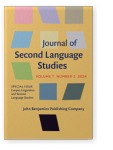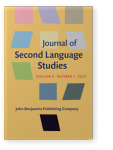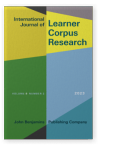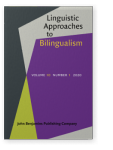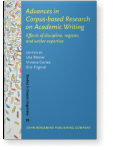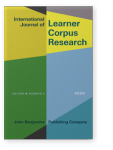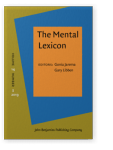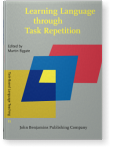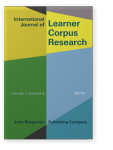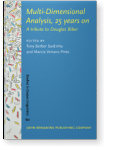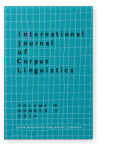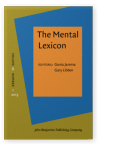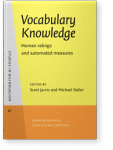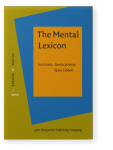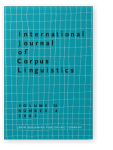Scott A. Crossley
List of John Benjamins publications for which Scott A. Crossley plays a role.
Journal
2023 Assessing receptive vocabulary using state‑of‑the‑art natural language processing techniques Journal of Second Language Studies 6:1, pp. 1–28 | Article
Semantic embedding approaches commonly used in natural language processing such as transformer models have rarely been used to examine L2 lexical knowledge. Importantly, their performance has not been contrasted with more traditional annotation approaches to lexical knowledge. This study used… read more
2023 The English Language Learner Insight, Proficiency and Skills Evaluation (ELLIPSE) Corpus International Journal of Learner Corpus Research 9:2, pp. 248–269 | Article
This paper introduces the open-source English Language Learning Insight, Proficiency and Skills Evaluation (ELLIPSE) corpus. The corpus comprises ~6,500 essays written by English language learners (ELLs). All essays were written during state-wide standardized annual testing in the United States.… read more
2020 The action dynamics of native and non-native speakers of English in processing active and passive sentences Linguistic Approaches to Bilingualism 10:1, pp. 58–85 | Article
This study investigates processing of passive and active constructions between native speakers (NS) and non-native speakers (NNS) of English using traditional on-line mechanisms such as response time in conjunction with techniques that capitalize on the parallel activation of distributed mental… read more
2020 Students’ use of lexical bundles: Exploring the discipline and writing experience interface Advances in Corpus-based Research on Academic Writing: Effects of discipline, register, and writer expertise, Römer-Barron, Ute, Viviana Cortes and Eric Friginal (eds.), pp. 115–134 | Chapter
This chapter presents the results of an investigation into the interaction between discipline and writing experience on lexical bundle (LB) production. The study compared the production of 4-word LBs by novice and expert writers in medical and non-medical fields. The findings indicated that a… read more
2020 Word lists and the role of academic vocabulary use in high stakes speaking assessments International Journal of Learner Corpus Research 6:2, pp. 193–219 | Article
The current study explored the extent to which academic vocabulary lists could meet the lexical demands of academic speaking assessments. Indices of word use from lists of academic and general vocabulary were used to predict speaking scores on three TOEFL tasks. The results found weak… read more
2019 Predictors of second language English lexical recognition: Further insights from a large database of second language lexical decision times The Mental Lexicon 14:3, pp. 333–356 | Article
In this study we analyze a large database of lexical decision times for English content words made by speakers of English as an additional language residing in the United States. Our first goal was to test whether the use of statistical measures better able to model variation associated with… read more
2018 Chapter 3. The effects of task repetition and task complexity on L2 lexicon use Learning Language through Task Repetition, Bygate, Martin (ed.), pp. 75–96 | Chapter
To date, a growing number of studies in instructed second language acquisition (SLA) have investigated the effects of task repetition on L2 performance (e.g., complexity, accuracy, fluency) as well as on the occurrence of interaction-driven learning opportunities (e.g., Bygate, 2001; Fukuta, 2016;… read more
2015 Native language identification and writing proficiency International Journal of Learner Corpus Research 1:2, pp. 187–209 | Article
This study evaluates the impact of writing proficiency on native language identification (NLI), a topic that has important implications for the generalizability of NLI models and detection-based arguments for cross-linguistic influence (Jarvis 2010, 2012; CLI). The study uses multinomial logistic… read more
2014 Chapter 3.1 A Multi-Dimensional analysis of essay writing: What linguistic features tell us about situational parameters and the effects of language functions on judgments of quality Multi-Dimensional Analysis, 25 years on: A tribute to Douglas Biber, Berber Sardinha, Tony and Marcia Veirano Pinto (eds.), pp. 197–238 | Article
This study applied the Multi-Dimensional analysis used by Biber (1988) to examine the functional parameters of essays. Co-occurrence patterns were identified within an essay corpus (n = 1529) using linguistic indices provided by Coh-Metrix. These patterns were used to identify essay groups that… read more
2014 Frequency effects and second language lexical acquisition: Word types, word tokens, and word production International Journal of Corpus Linguistics 19:3, pp. 301–332 | Article
Frequency effects in an L1 and L2 longitudinal corpus were investigated using Zipfian distribution analyses and linear curve estimations. The results demonstrated that the NS lexical input exhibited Zipfian distributions, but that the L2 lexical output did not match the NS Zipfian patterns. Word… read more
2013 Assessing automatic processing of hypernymic relations in first language speakers and advanced second language learners: A semantic priming approach The Mental Lexicon 8:1, pp. 96–116 | Article
This study investigates the depth of lexical knowledge in first language (L1) speakers and second language (L2) learners in reference to hierarchical word knowledge. Eighty-eight participants took part in a lexical decision task that assessed their speed and accuracy in recognizing words and… read more
2013 Chapter 5. Computer simulations of MRC Psycholinguistic Database word properties: Concreteness, familiarity, and imageability Vocabulary Knowledge: Human ratings and automated measures, Jarvis, Scott and Michael Daller (eds.), pp. 135–156 | Chapter
This study investigates the potential for computational models informed through automated lexical indices to simulate human ratings of word concreteness, word familiarity, and word imageability. The goal of the study is to provide word information estimates for words with human ratings, thereby… read more
2013 Chapter 4. Validating lexical measures using human scores of lexical proficiency Vocabulary Knowledge: Human ratings and automated measures, Jarvis, Scott and Michael Daller (eds.), pp. 105–134 | Chapter
This study examines the convergent validity of a wide range of computational indices reported by Coh-Metrix that have been associated in past studies with lexical features such as basic category words, semantic co-referentiality, word frequency, and lexical diversity. This study uses human… read more
2010 Using lexical indices to predict produced and not produced words in second language learners The Mental Lexicon 5:1, pp. 115–147 | Article
The paper explores how linguistic indices related to lexical networks and psycholinguistic models of lexical knowledge can be used to predict produced and not produced words in second language (L2) speakers. Two hypotheses are tested in this study. The first addresses how lexical properties thought… read more
2007 Multi-dimensional register classification using bigrams International Journal of Corpus Linguistics 12:4, pp. 453–478 | Article
A corpus linguistic analysis investigated register classification using frequency of bigrams in nine spoken and two written corpora. Four dimensions emerged from a factor analysis using bigram frequencies shared across corpora: (1) Scripted vs. Unscripted Discourse, (2) Deliberate vs. Unplanned… read more
